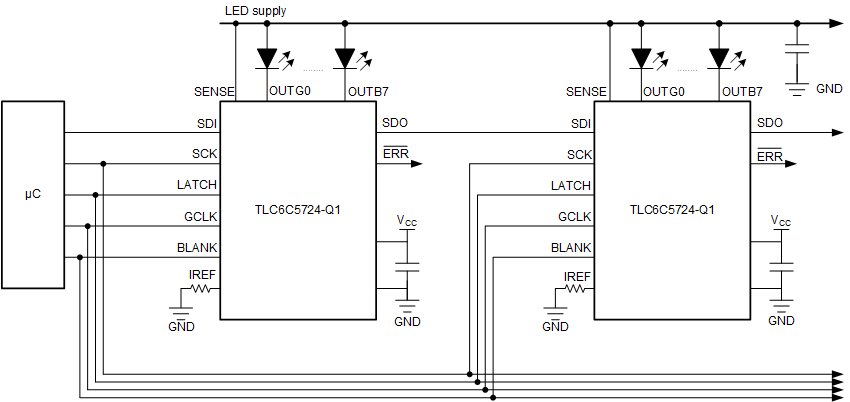ZHCSIO0A December 2017 – August 2018 TLC6C5724-Q1
PRODUCTION DATA.
- 1 特性
- 2 应用
- 3 说明
- 4 修订历史记录
- 5 Pin Configuration and Functions
- 6 Specifications
-
7 Detailed Description
- 7.1 Overview
- 7.2 Functional Block Diagram
- 7.3
Feature Description
- 7.3.1 Maximum Constant-Sink-Current Setting
- 7.3.2 Brightness Control and Dot Correction
- 7.3.3 Grayscale Configuration
- 7.3.4
Diagnostics
- 7.3.4.1 LED Diagnostics
- 7.3.4.2 Adjacent-Pin-Short Check
- 7.3.4.3 IREF Short and IREF Open Detection
- 7.3.4.4 Pre-Thermal Warning Flag
- 7.3.4.5 Thermal Error Flag
- 7.3.4.6 Negate Bit Toggle
- 7.3.4.7 LOD_LSD Self-Test
- 7.3.4.8 ERR Pin
- 7.3.4.9 ERROR Clear
- 7.3.4.10 Global Reset
- 7.3.4.11 Slew Rate Control
- 7.3.4.12 Channel Group Delay
- 7.4 Device Functional Modes
- 7.5 Programming
- 7.6 Register Maps
- 8 Application and Implementation
- 9 Power Supply Recommendations
- 10Layout
- 11器件和文档支持
- 12机械、封装和可订购信息
8.2 Typical Application
In automotive LCD display applications such as a solid-state cluster or center information display, LED backlighting is one of the key parts for the display. Today most LED backlighting is the traditional edge-lit type, which means the backlighting is globally dimmed. This method consumes much power and causes light leakage from the liquid crystals in the black areas, as the backlighting is always turned on. Recently, local-dimming backlighting, a direct-lit type of backlighting, has been proposed to overcome this drawback. The lighting level of the backlighting follows the display contents. The lighting level is dynamically adjusted by the content of the image blocks for local-dimming control. When an image block is bright, the lighting level of the backlighting turns high also. Conversely, the backlighting level is adjusted to low in a black region. This arrangement reduces power dissipation and light leakage from the LCD and creates pure black, increasing the image contrast ratio.
Users can use the TLC6C5724-Q1 device to drive LED backlighting in local dimming applications. Depending how many zones are in the display, users can connect different numbers of TLC6C5724-Q1 devices in a daisy chain to drive the LEDs.
 Figure 31. Typical Block Diagram for Local Dimming
Figure 31. Typical Block Diagram for Local Dimming